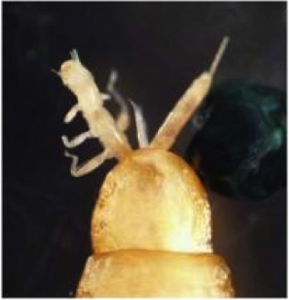Functional Feeding Groups: Predators

Figure 8.23: An engulfing predator shown here with prey in its mouth! Photo from Rhithron Associates.
Probably the most notable aquatic predators are the fish; however, many aquatic insects are also predators. Aquatic insect predators consume their prey in one of two primary ways, by either engulfing or piercing.
Engulfing predators use their large jaws to capture and engulf their prey, often eating the prey organism nearly whole. Dragonfly and damselfly larvae have a hinged jaw, an adaptation which allows them to quickly open and close their mouths to consume large prey, as you can see by watching the video below:
Some other insect groups, like true bugs, have a proboscis that allows them to pierce the skin and ingest the bodily fluids of their prey. Lethocerus species are well known for their ability to attack fish, and sometimes the toe of an unsuspecting swimmer, giving this species the common name “toe biter.”

Figure 8.24: Aquatic insect that is a true bug and also known as the “toe biter.” It pierces its prey and sucks out the contents. Shown here eating a fish! Image from Rhithron Associates.
Click here for an inquiry activity from the UM ECOS Project on “Feeding the Hungry Stoneflies” (pdf format).